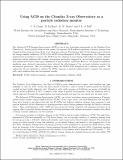Using ACIS on the Chandra X-ray Observatory as a particle radiation monitor
Author(s)
La Marr, Beverly J.; Bautz, Marshall W.; O'Dell, S. L.; Grant, Catherine E
DownloadGrant-2010-Using ACIS on the Chandra X-ray Observatory as a particle radiation monitor.pdf (497.6Kb)
PUBLISHER_POLICY
Publisher Policy
Article is made available in accordance with the publisher's policy and may be subject to US copyright law. Please refer to the publisher's site for terms of use.
Terms of use
Metadata
Show full item recordAbstract
The Advanced CCD Imaging Spectrometer (ACIS) is one of two focal-plane instruments on the Chandra X-ray Observatory. During initial radiation-belt passes, the exposed ACIS suffered significant radiation damage from trapped soft protons scattering off the x-ray telescope's mirrors. The primary effect of this damage was to increase the charge-transfer inefficiency (CTI) of the ACIS 8 front-illuminated CCDs. Subsequently, the Chandra team implemented procedures to remove the ACIS from the telescope's focus during high-radiation events: planned protection during radiation-belt transits; autonomous protection triggered by an on-board radiation monitor; and manual intervention based upon assessment of space-weather conditions. However, as Chandra's multilayer insulation ages, elevated temperatures have reduced the effectiveness of the on-board radiation monitor for autonomous protection. Here we investigate using the ACIS CCDs themselves as a radiation monitor. We explore the 10-year database to evaluate the CCDs' response to particle radiation and to compare this response with other radiation data and environment models.
Date issued
2010-07Department
MIT Kavli Institute for Astrophysics and Space ResearchJournal
Proceedings of SPIE--the International Society for Optical Engineering
Publisher
SPIE
Citation
C. E. Grant, B. LaMarr, M. W. Bautz and S. L. O'Dell, "Using ACIS on the Chandra X-ray Observatory as a particle radiation monitor", Proc. SPIE 7732, 77322I (2010); doi:10.1117/12.857629 © 2010 SPIE
Version: Final published version
ISSN
0277-786X